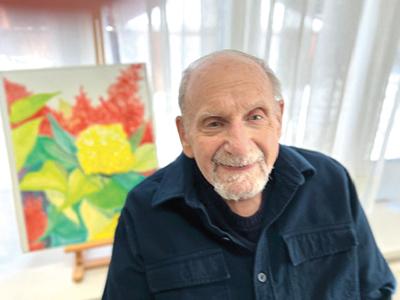Gil Cornfield, ’54: An Employment Lawyer Whose Labor of Love is Art

Gil Cornfield, ’54, was 21 years old when he graduated from the Law School, having completed his undergraduate degree at UChicago in two years. Before he was 30, he had cofounded the law firm where he still practices today, and he had argued and won two cases at the United States Supreme Court.
The primary focus of his practice has been union-side labor law. The more than 20 unions that have been represented by his firm include the steelworkers’ union—in the years when there were more than 150,000 steelworkers in the Chicago area—and two of the largest unions in Illinois, the Illinois Federation of Teachers and the state council of the American Federation of State, Municipal and County Employees.
“For me,” he said, “Just practicing law would not have been enough. I needed to feel that I was helping to create some kind of justice for people in a society that is too often unjust. One of the career choices I seriously considered was becoming a rabbi. Maybe this has been a secular version of that calling.”
When Martin Luther King Jr. brought the civil rights movement to Chicago in 1966 with a focus on fair housing, Cornfield took on a central role, pro bono, as a strategist and activist. In a 2007 law review article, Richard Chused, ’68, reflected, “Gil Cornfield was a stalwart—maybe a hero—of the tenant movement in Chicago.” In 1972, Cornfield won a historic decision from the Illinois Supreme Court establishing a common-law warrant of habitability that shifted the balance of power between tenants and landlords.
Around that same time, Cornfield also persuaded a federal judge that party affiliation was an unlawful basis for firing decisions by government officials, arguing that such actions violated the First Amendment.
Although union membership in Illinois generally declined for many years—accelerated by the anti-union actions of the Reagan administration—Cornfield’s firm, Cornfield and Feldman, grew as a result of two 1980s state laws that supported collective bargaining by teachers and other public employees. He achieved a significant victory in 2000 when Illinois courts upheld the right to unionize one of his clients, an organization representing several thousand University of Illinois graduate students who handled teaching duties and other employee functions.
As successful as he has been, there were two times when it seemed Cornfield might not become a lawyer at all. One of those came when he sought admission to the bar after graduation. “There was a big group of us waiting to go before the character and fitness committee,” he recalled. “One by one, the others went in and soon came out, looking happy. I was the last person called, and the committee demanded to know whether I was a communist. I wasn’t, but they seemed to think that I was. In any event, I refused to answer that question, and they didn’t take any action against me, but it was a tense and disturbing time, particularly because a UChicago Law graduate had been denied admission to the bar three years earlier for being a communist.”
Not long afterward, he again faced the possibility of not practicing law. After serving in the army for two years, he went to Italy to study art, financing his time there with a combination of scant savings and money he had won playing poker with his fellow soldiers. An art collector admired his work and offered to arrange a gallery showing.
“I had loved doing art from the time I was a very small child, and that exhibition could possibly have been my break to become a full-time artist,” he said. “But in the short term my money was running out, and for the longer term I had to weigh the security and satisfactions of a legal practice against the insecurity of an art career.”
He came back to the States and joined a law firm, but the love of making art never left him. Today, while still serving some clients, he spends much of his time in his studio.
“If you had asked me a few years ago what I do, I would have answered, ‘I’m a labor lawyer,’” he said. “Today, my answer is, ‘I’m an artist who sometimes practices labor law.’”